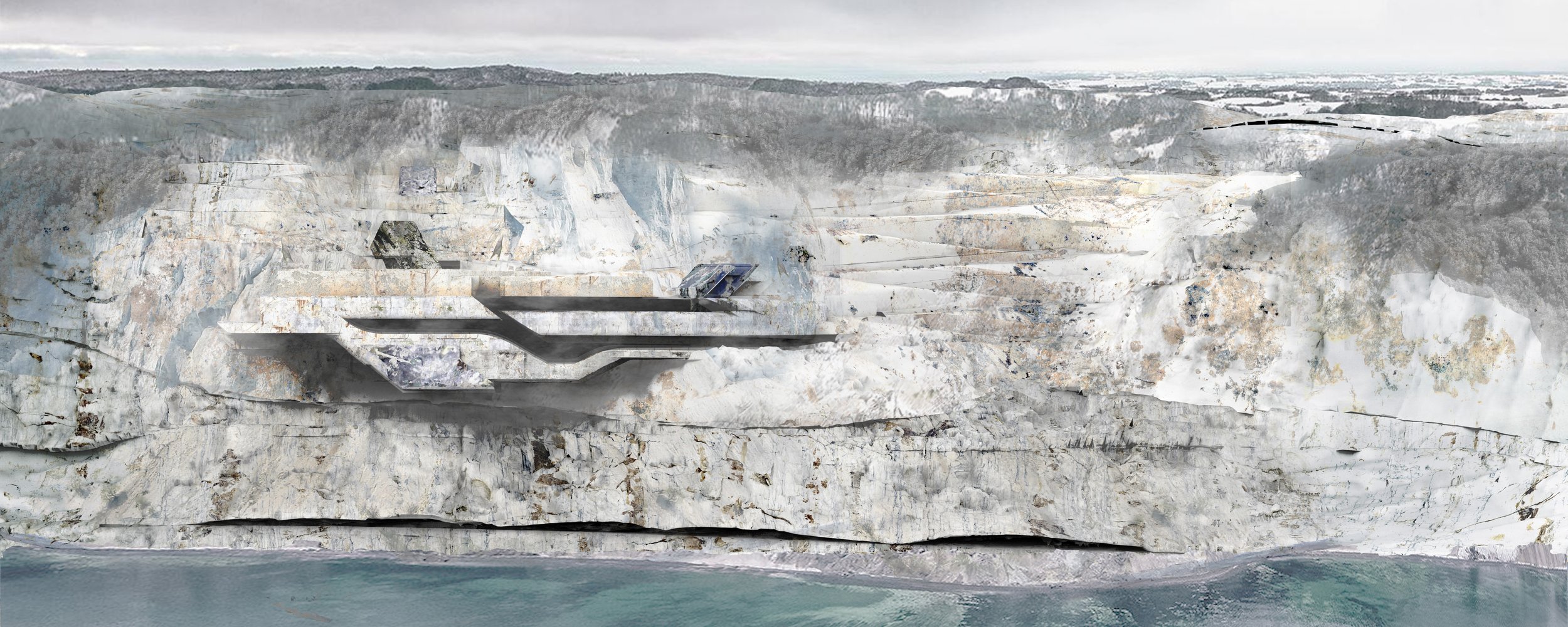
ARCH 704 | Spring 2023
Studio Critics: Winka Dubbeldam, Richard Garber & Merrick Castilo
Partner with Kewei Lin
Drawing inspiration from the Latin phrase "ancient word," our project, “Logos Antiquus,” seeks to bridge the gap between the past and the present through research and design. This endeavor aims to cultivate a meaningful discourse that connects historical and contemporary perspectives.
Site Research
Møns Klint is globally recognized for its exceptional glaciotectonic formations.
These structures bear resemblance to those found in thrust-fault belts produced by gravity-induced spreading. The Møns Klint Glaciotectonic Complex hosts remarkable thrust sheets, with the most prominent one being the Maastrichtian chalk. This chalk constitutes a crucial component of the vast carbonate platform that enveloped a large portion of Northern Europe during the late Cretaceous epoch.
Our paleontology research center is situated in the northern area of this notable site.

The Møns Klint Glaciotectonic Complex, which is prominently revealed along the north-south chalk cliff on the eastern shore of Møn Island in southeast Denmark, stands as one of the world's most renowned glacio-tectonic landmarks. Situated near the Bornholm Thrust Belt, a geological structure created by the convergence of tectonic plates, Møns Klint is a part of the greater Teisseyre-Tornquist Zone that spans much of Scandinavia and northern Europe. This tectonic plate collision resulted in the formation of a significant fold-and-thrust belt, characterized by the presence of large anticlines and synclines in the underlying rock formations.

This illustrates the stratigraphic and structural framework of the southern imbricate fan at Møns Klint. The thickness of the lithological units varies, particularly the glaciofluvial sand situated above the Mid Danish Till, which increases in thickness where the sand was deposited in piggyback basins during thrust-fault deformation. The unit is unofficially referred to as the "elephant clay" due to its unique erosion features. During the Late Weichselian glacial maximum, the Swedish Ice advanced over the eastern portion of the Danish Basin towards the Main Stationary Line, resulting in the deposition of the Mid Danish Till on Møn.

The cross-sections were designed to be perpendicular to the final deformation's fold axis, which resulted in the formation of a recumbent anticline-syncline pair beneath a thrust fault with a 20-meter displacement. This folding pattern is visible in the glacial layers below the initial deformation's thrust-fault plane, which is responsible for the distinctive wedge-shaped feature at the top of the fold. The strike of the primary deformation thrust is not parallel to the secondary phase fold axis, causing the wedge's position to vary between cross-sections. In the fifth cross-section, the thrust wedge's tip reaches the edge of the cliff, corresponding to the wedge exposure immediately to the right of Maglevandsfald.
Material Research
In our exploration of construction materials for Mons Klint, we prioritized using local and recycled materials in the concrete mix to minimize the project's ecological footprint.
We discovered that incorporating recycled glass into the mix can decrease the reliance on new materials, while fiber reinforcement enhances the concrete's strength, longevity, and resistance to cracking.
Wool fibers, a sustainable and natural resource, can also be employed to fortify the concrete and boost its insulating properties. Conversely, steel wool serves as a conductive component in concrete, safeguarding the structure from electrical harm.
Lastly, seagrass and straw bale, abundant in Mons Klint and other Danish islands, can further strengthen and extend the concrete's lifespan while championing environmental sustainability.
By integrating these materials into the concrete mix, the construction of Mons Klint can become eco-friendlier and mitigate its overall impact on the environment.
Project Proposal
Our design pays a remarkable homage to the natural splendor of Møns Klint. Drawing inspiration from the striking geological formation, the design showcases bold, sweeping lines that echo the cliff face's contours. The exterior employs materials mimicking the chalk formations at the site, featuring smooth, curved surfaces that encapsulate the area's innate beauty.
Within, the building perpetuates the reflection of Møns Klint's geology. Using organic shapes fosters an atmosphere that resembles an extension of the surrounding landscape. The design integrates various textures, ranging from coarse to sleek, polished surfaces, emulating the natural contrasts of the cliff face. We aim to establish different volumes representing diverse programs, forming the building.
The structure's distinct features also acknowledge the area's geological history. Incorporating sustainable materials and energy-efficient systems signifies the long-term perspective required to comprehend the geological processes of Møns Klint.
Our architectural design pays homage to the breathtaking beauty of Mons Klint. Drawing inspiration from the remarkable geological structure, the building's design showcases striking, fluid lines that echo the cliff's contours. The exterior employs materials that mimic the site's chalk formations, exhibiting sleek, curved surfaces that capture the area's natural allure. Furthermore, the concrete material offers shelter for indigenous wildlife, such as falcons, creating harmony between the built environment and nature.













